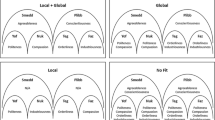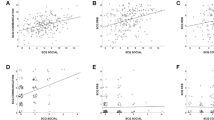Abstract
Although taxonomic issues may seem remote from everyday work with disturbed children, they lurk about in many guises. We will first consider these guises and then discuss ways to give taxonomy a more open and constructive role in helping disturbed children.
Access this chapter
Tax calculation will be finalised at checkout
Purchases are for personal use only
Preview
Unable to display preview. Download preview PDF.
Similar content being viewed by others
References
Achenbach, T. M. The Child Behavior Profile: I. Boys 6–11. Journal of Consulting and Clinical Psychology, 1978, 46, 478–488.
Achenbach, T. M. The Child Behavior Profile: An empirically based system for assessing children’s behavioral problems and competencies. International Journal of Mental Health, 1979, 7, 24–42.
Achenbach, T. M. DSM-HI in light of empirical research on the classification of child psychopathology. Journal of the American Academy of Child Psychiatry, 1980, 19, 395–412.
Achenbach, T. M. The role of taxonomy in developmental psychopathology. In M. E. Lamb & A. L. Brown (Eds.), Advances in developmental psychology. Hillsdale, N.J.: Lawrence Erlbaum, 1981.
Achenbach, T. M. Developmental psychopathology (2nd ed.). New York: Wiley, 1982.
Achenbach, T. M., & Edelbrock, C. S. The classification of child psychopathology: A review and analysis of empirical efforts.Psychological Bulletin, 1978, 85, 1275–1301.
Achenbach, T. M., & Edelbrock, C. S. The Child Behavior Profile: II. Boys aged 12–16 and girls aged 6–11 and 12–16. Journal of Consulting and Clinical Psychology, 1979, 47, 223–233.
Achenbach, T. M., & Edelbrock, C. S. Behavioral problems and competencies reported by parents of normal and disturbed children aged 4 through 16. Monographs of the Society for Research in Child Development, 1981, 46 (1, Serial No. 188).
Ackerson, L. Children’s behavior problems: Vol. 2. Relative importance and interrelations among traits. Chicago: University of Chicago Press, 1942.
American Psychiatric Association. Diagnostic and statistical manual of mental disorders, Washington, D.C.: Author, 1st ed., 1952; 2nd ed., 1968; 3rd ed., 1980.
Anderberg, M. R. Cluster analysis for applications. New York: Academic Press, 1973.
Baggaley, A. R. Intermediate correlational methods. New York: Wiley, 1964.
Bailey, K. D. Cluster analysis. In D. Heise (Ed.), Sociological methodology. San Francisco: Jossey-Bass, 1974.
Ball, G., & Hall, D. J. A clustering procedure for summarizing multivariate data. Behavioral Science, 1967, 12, 153–155.
Bartko, J. J. On various intraclass correlation reliability coefficients. Psychological Bulletin, 1976, 83, 762–765.
Beitchman, J. H., Dielman, T. E., Landis, J. R., Benson, R. M., & Kemp, P. L. Reliability of the Group for the Advancement of Psychiatry diagnostic categories in child psychiatry. Archives of General Psychiatry, 1978, 1461–1466.
Blashfield, R. K. Mixture model tests of cluster analysis: Accuracy of four agglomerative hierarchical methods. Psychological Bulletin, 1976, 83, 377–388.
Borkovec, T. D. Autonomic reactivity to sensory stimulation in psychopathic, neurotic, and normal juvenile delinquents. Journal of Consulting and Clinical Psychology, 1970, 35, 217–222.
Butler, E. W., & Adams, S. W. Typologies of delinquent girls: Some alternative approaches. Social Forces, 1966, 44, 401–407.
Cohen, J. Statistical power analysis for the behavioral sciences (Rev. ed.). New York: Academic Press, 1977.
Collins, H. A., Burger, G. K., & Taylor, G. A. An empirical typology of heroin abusers. Journal of Clinical Psychology, 1976, 32, 473–476.
Cronbach, L. J., & Gleser, G. Assessing similarity between profiles. Psychological Bulletin, 1953, 50, 456–473.
D’Andrade, R. G. U-statistic hierarchical clustering. Psychometrika, 1978, 43, 59–67.
Dubes, R., & Jain, A. K. Validity studies in clustering methodologies. Pattern Recognition, 1979, 11, 235–254.
Eades, D. C. The inappropriateness of the correlation coefficient as a measure of taxonomic resemblance. Systematic Zoology, 1965, 14, 98–100.
Edelbrock, C. Mixture model tests of hierarchical clustering algorithms: The problem of classifying everybody. Multivariate Behavioral Research, 1979, 14, 367–384.
Edelbrock, C., & Achenbach, T. M. A typology of Child Behavior Profile patterns: Distribution and correlates for disturbed children aged 6–16. Journal of Abnormal Child Psychology, 1980, 8, 441–470.
Edelbrock, C., & McLaughlin, B. Hierarchical cluster analysis using intraclass correlations: A mixture model study. Multivariate Behavioral Research, 1980, 15, 299–318.
Everitt, B. S. Cluster analysis. London: Halsted, 1974.
Fleiss, J. L., Lawlor, W., Platman, S. R., & Fieve, R. R. On the use of inverted factor analysis for generating typologies. Journal of Abnormal Psychology, 1971, 77, 127–132.
Fleiss, J. L., & Zubin, J. On the methods and theory of clustering. Multivariate Behavioral Research, 1969, 4, 235–250.
Freeman, M. A reliability study of psychiatric diagnosis in childhood and adolescence.Journal of Child Psychology and Psychiatry, 1971, 12, 43–54.
Freud, A. Normality and pathology in childhood. New York: International Universities Press, 1965.
Freud, S. Inhibitions, symptoms, and anxiety. In Standard edition of the complete psychological works of Sigmund Freud (Vol. 20). London: Hogarth Press, 1959. (Originally published, 1926.)
Greenspan, S. L, Hatleberg, J. L., & Cullander, C. C. H. A developmental approach to systematic personality assessment: Illustrated with the case of a 6-year-old child. In S. I. Greenspan & G. Pollock (Eds.), The course of life: Psychoanalytic contributions toward understanding personality development. Vol. 2: Latency, adolescence, and youth, Washington, D.C.: Department of Health, Education and Welfare, 1979.
Gregson, R. Psychometrics of similarity. New York: Academic Press, 1975.
Griesinger, W. Mental pathology and therapeutics (C. L. Robertson & J. Rutherford, trans.). London: New Sydenham Society, 1867. (Originally published, 1845.)
Group for the Advancement of Psychiatry.Psychopathological disorders in childhood: Theoretical considerations and a proposed classification, (Report No. 62). New York: Group for the Advancement of Psychiatry, 1966.
Guze, S. B. Validating criteria for psychiatric diagnosis: The Washington University approach. In H. S. Akiskal & W. L. Webb (Eds.), Psychiatric diagnosis: Exploration of biological predictors. New York: Spectrum, 1978.
Hewitt, L. E., & Jenkins, R. L. Fundamental patterns of maladjustment: The dynamics of their origin. A statistical analysis based upon five hundred case records of children examined at the Michigan Child Guid-Institute. Springfield, Ill: State of Illinois, 1946.
Jenkins, R. L., & Glickman, S. Common syndromes in child psychiatry: I. Deviant behavior traits. II. The schizoid child. American Journal of Orthopsychiatry, 1946, 16, 244–261.
Jones, K. J. Problems of grouping individuals and the method of modality. Behavioral Science, 1968, 13, 496–511.
Kanner, L. Autistic disturbances of affective contact. Nervous Child, 1943, 2, 217–250.
Kraepelin, E. Psychiatrie (8th ed.). Leipzig: Barth, 1915. (Originally published, 1883.)
Kuiper, F. K., & Fisher, L. A Monte Carlo comparison of six clustering procedures. Biometrics, 1975, 31, 777–783.
Lief, A. The common sense psychiatry of Dr. Adolf Meyer. New York: McGraw-Hill, 1948.
Ling, R. F. Probability theory of cluster analysis. Journal of the American Statistical Association, 1973, 68, 159–164.
Ling, R. F. An exact probability distribution on the connectivity of random graphs.Journal of Mathematical Psychology, 1975, 12, 90–98.
Ling, R. F., & Killough, G. S. Probability tables for cluster analysis based on a theory of random graphs. Journal of the American Statistical Association, 1976, 71, 293–300.
Lorr, M. (Ed.). Explorations in typing psychotics. Oxford: Pergamon Press, 1966.
MacQueen, J. Some methods for classification and analysis of multivariate observations. In L. M. Lecam & J. Neyman (Eds.), Proceedings of the fifth Berkeley Symposium on Mathematical Statistics and Probability (Vol. 1). Berkeley: University of California Press, 1967.
Mattison, R., Cantwell, D. P., Russell, A. T., & Will, L. A comparison of DSM-II and DSM-III in the diagnosis of childhood psychiatric disorders. Archives of General Psychiatry, 1979, 36, 1217–1222.
Mclntyre, R. M., & Blashfield, R. K. A nearest-centroid technique for evaluating the minimum-variance clustering procedure. Multivariate Behavioral Research, 1980, 15, 225–238.
McRae, D. J. MICKA: A FORTRAN IV iterative K-means cluster analysis program. Behavioral Science, 1971, 77,423–424.
Meehl, P. E. Theoretical risks and tabular asterisks: Sir Karl, Sir Ronald, and the slow progress of soft psychology. Journal of Consulting and Clinical Psychology, 1978, 46, 806–834.
Mezzich, A. C., & Mezzich, J. E. Diagnostic reliability of childhood and adolescence behavior disorders. Presented at the American Psychological Association, New York, September 1979.
Mezzich, J. E. Evaluating clustering methods for psychiatric diagnosis. Biological Psychiatry, 1978, 13, 265–281.
Miller, L. C. Louisville Behavior Checklist manual. Los Angeles: Western Psychological Services, 1977.
Milligan, G. W. An examination of the effect of six types of error perturbation on fifteen clustering algorithms. Psychometrika, 1980, 45, 325–342.
Mojena, R. Hierarchical grouping methods and stopping rules: An evaluation. Computer Journal, 1977, 20, 359–363.
Monro, A. B. Psychiatric types: A Q-technique study of 200 patients. Journal of Mental Science, 1955, 101, 330–343.
Prior, M., Perry, D., & Gajzago, C. Kanner’s syndrome or early onset psychosis: A taxonomic analysis of 142 cases. Journal of Autism and Childhood Schizophrenia, 1975, 5, 71–80.
Quay, H. C. Classification. In H. C. Quay & J. S. Werry (Eds.), Psychopathological disorders of childhood (2nd ed.). New York: Wiley, 1979.
Quay, H.C., & Peterson, D. R. Manual for the Behavior Problem Checklist. Unpublished manuscript. University of Illinois, 1968; University of Miami, 1975.
Roth, M. Psychiatric diagnosis in clinical and scientific settings. In H. S. Akiskal & W. L. Webb (Eds.), Psychiatric diagnosis: Exploration of biological predictors. New York: Spectrum, 1978.
Skinner, H. A. Differentiating the contribution of elevation, scatter, and shape in profile similarity. Educational and Psychological Measurement, 1978, 38, 297–308.
Sneath, P. H., & Sokal, R. R. Numerical taxonomy: The principles and practice of numerical classification. San Francisco: Freeman, 1973.
Spitzer, R. L., & Cantwell, D. P. The DSM-III classification of the psychiatric disorders of infancy, childhood, and adolescence. Journal of the American Academy of Child Psychiatry, 1980, 19, 356–370.
Spitzer, R. L., Endicott, J., & Robins, E. Research diagnostic criteria: Rationale and reliability. Archives of General Psychiatry, 1978, 35, 773–782.
Spitzer, R. L., Williams, J. B. W., & Skodol, A. E. DSM-III: The major achievements and an overview. American Journal of Psychiatry, 1980, 137, 151–164.
Stephenson, W. Introduction to inverted factor analysis with some applications to studies of orexsis. Journal of Educational Psychology, 1936, 27, 353–367.
Strauss, D. J. A model for clustering. Biometrika, 1975, 62, 467–475.
Ward, J. H. Hierarchical grouping to optimize an objective function. Journal of the American Statistical Association, 1963, 38, 236–244.
Woolf, H. B. (Ed.). Webster’s new collegiate dictionary. Springfield, Mass.: G. & C. Merriam, 1977.
Author information
Authors and Affiliations
Editor information
Editors and Affiliations
Rights and permissions
Copyright information
© 1983 Springer Science+Business Media New York
About this chapter
Cite this chapter
Achenbach, T.M., Edelbrock, C.S. (1983). Taxonomic Issues in Child Psychopathology. In: Ollendick, T.H., Hersen, M. (eds) Handbook of Child Psychopathology. Springer, Boston, MA. https://doi.org/10.1007/978-1-4615-7136-0_4
Download citation
DOI: https://doi.org/10.1007/978-1-4615-7136-0_4
Publisher Name: Springer, Boston, MA
Print ISBN: 978-1-4615-7138-4
Online ISBN: 978-1-4615-7136-0
eBook Packages: Springer Book Archive




